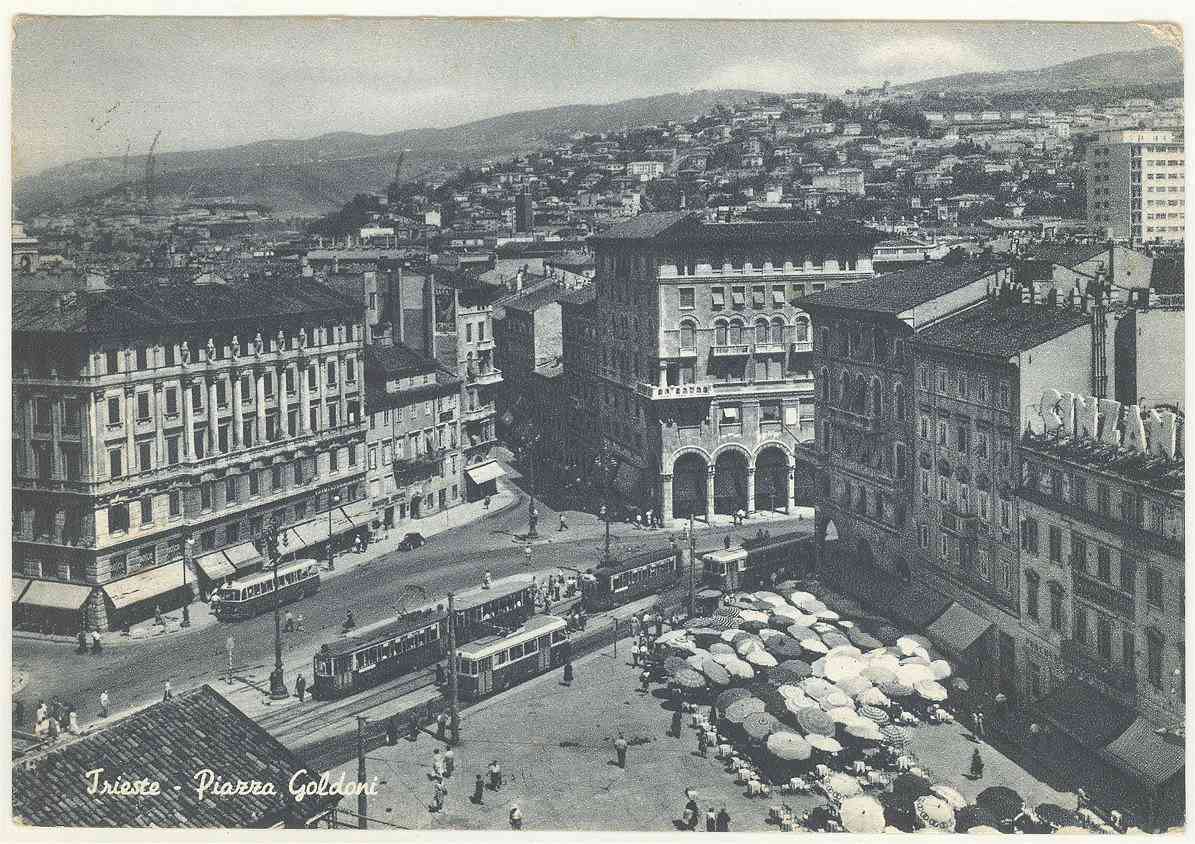
Doncaster Corporation Tramways was an electric tramway network serving the town of Doncaster, England. It was authorised in 1899, and the first route to Bentley opened in 1902. This remained separated from the rest of the system until North Bridge was built to carry traffic over the Great Northern Railway main line to Edinburgh. Soon afterwards, deep mining of coal began in the area, and several extensions to the system were made between 1913 and 1916 to serve new communities which developed around the pit heads. The Racecourse route was unusual, in that it had balloon loops at both ends to enable almost continuous running on race days, a feature that was not common in England, and only found favour in Europe in the 1950s and 1960s.

The Trieste–Opicina tramway is an unusual hybrid tramway and funicular railway in the city of Trieste, Italy. It links Piazza Oberdan, on the northern edge of the city centre, with the village of Villa Opicina in the hills above.

Dundee Corporation Tramways formerly served the City of Dundee in Scotland. The corporation had financed the construction of a horse tramway in 1877, but had then leased it to the Dundee and District Tramways Company. They had replaced most of the horse trams with steam tram locomotives pulling trailer cars from 1884, but in 1897 the corporation decided that it would run the tramway system itself. After some negotiation and the payment of compensation, they took over the system in 1899, with a view to electrifying it. Electric trams started running in 1900, and the changeover was completed in 1902.
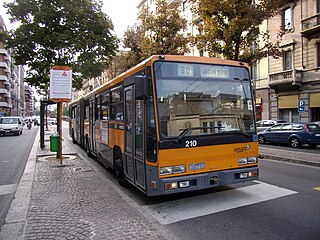
The Milan trolleybus system is part of the public transport network of Milan, Italy. In operation since 1933, the system presently comprises four routes. It is the second-oldest trolleybus system in Europe, after that of Lausanne, and the fifth-oldest in the world.
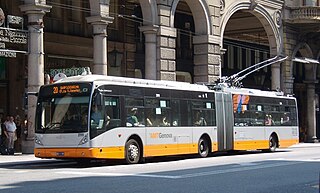
The Genoa trolleybus system forms part of the public transport network of the city and comune of Genoa, in the region of Liguria, northern Italy. In operation since 1997, the system currently comprises only one route. Between 2008 and 2012, two routes were being operated.
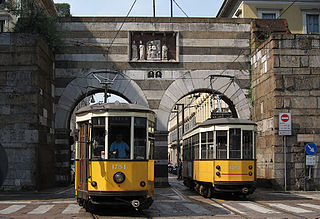
The Milan tramway network is part of the public transport network of Milan, Italy, operated by Azienda Trasporti Milanesi (ATM).

The Wolverhampton trolleybus system served the city of Wolverhampton, then in Staffordshire, England, for much of the twentieth century.

The Grimsby trolleybus system once served the seaport of Grimsby, in Lincolnshire, England. Opened on 3 October 1926, it gradually replaced part of the Great Grimsby Street Tramways, a tramway that had served both Grimsby and the neighbouring holiday resort of Cleethorpes. It was closed on 4 June 1960.
Southend-on-Sea Corporation Transport was the overarching name given to the local municipal transport services provided to the town of Southend-on-Sea by the local council. Initially started as a tramway, although known officially as Southend-on-Sea Corporation Light Railway, the trams started operating on 19 July 1901 until the service was terminated on 8 April 1942. A trolleybus system was introduced in 16 October 1925, gradually replacing the tramway, before it closed on 28 October 1954. Motorbuses were first run by the Corporation in 1914, but two years later they withdrew the services. Buses did not return to the Corporation's service until 1932, eventually replacing the trams and trolleybuses. In 1974, the organisation was renamed Southend Transport, and after the Transport Act of 1985, it became involved in a bus war with rival Thamesway. The council sold Southend Transport to British Bus group in June 1993, which in turn was taken over by the Cowie group. Cowie was renamed Arriva in August 1998, with Southend Transport becoming Arriva serving Southend.

The Santos trolleybus system forms part of the public transport network in Santos, a municipality in the state of São Paulo, Brazil. Opened on 12 August 1963, it presently comprises only one line, and, along with the two São Paulo metropolitan area trolleybus systems, is one of only three trolleybus systems still operating in Brazil.
Aberdare Urban District Council Tramways operated a tramway service in Aberdare between 1913 and 1935. It was the only system in the United Kingdom which consisted of a tramway with feeder services run by trolleybuses from the start. The trolleybuses used the Austrian Cedes-Stoll system, and became increasingly difficult to maintain. Parts of the trolleybus network were converted to tramways in the early 1920s, and the rest stopped operating in 1925, when no trolleybuses were available for service. The tramway continued for another ten years, but was closed in 1934 and 1935 as a result of a downturn in the prosperity of Aberdare, due to collieries closing and the population dwindling. Motor buses took over the local services once the tramway had closed.
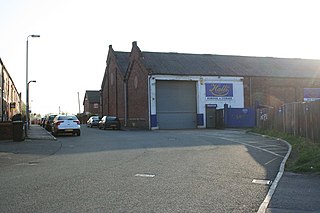
Wigan Corporation Tramways operated a tramway service in Wigan, England, between 1901 and 1931. The first tramway service in the town was run by the Wigan Tramways Company, whose horse trams began carrying passengers in 1880. They began replacing horses with steam tram locomotives from 1882, but the company failed in 1890 when a Receiver was appointed to manage it. The Wigan & District Tramways Company took over the system in 1893 and ran it until 1902. Meanwhile, Wigan Corporation were planning their own tramway system, obtaining an authorising act of Parliament in 1893, and a second act of Parliament in 1898. This enabled them to build electric tramways, and in 1902, they took over the lines of the Wigan & District Tramways Company.
At the peak of Britain’s first-generation tramways, it was possible to travel by tram all the way from Pier Head at Liverpool to the Pennines in Rochdale by tram.
Pontypridd Urban District Council Tramways operated a tramway service in Pontypridd between 1904 and 1931. Part of it used the route of the Pontypridd and Rhondda Valley Tramway Company's horse tramway. Between 1919 and 1927, it was the only system in Wales where through running onto a neighbouring system occurred. In 1930, part of the system was converted to use trolleybuses, and the former horse tramway section was replaced by motor buses in 1931, bringing the tramway era to an end. During the Second World War, a number of trolleybuses were borrowed from other systems, to cope with heavy traffic, but the use of electric vehicles ended in 1957. Most of the vehicles were sold on to other undertakings, and the system was the last in Britain to be run by an Urban District Council.

Alfa Romeo 140AF is an Italian trolleybus produced from 1949 to 1960.

The Lugano tramway network was part of the public transport network of Lugano, in the canton of Ticino, Switzerland, for over half a century. Opened in 1896, the network was progressively replaced by the Lugano trolleybus system by 1959, with one independent line surviving until 1964.

ATAC S.p.A. is an Italian publicly owned company running most of the local public transportation services, paid parking and incentive parking lots in Rome. More specifically, the company handles, on behalf of Roma Capitale Authority, the entire tramway, trolleybus network and metro lines, as well as most of the bus lines in the city. ATAC S.p.A., with its 2,200-kilometer-wide public transport network, its over 8,500 busses and 70,000 parking stalls, is currently one of the biggest public transportation companies in Europe and the largest in Italy.

Trieste's urban tramway system was operational from 1876 until 1970.
Bradford Corporation Tramways were a tramway network in the city of Bradford, West Riding of Yorkshire, England which operated trams from 1882 until 1950 and trolleybuses from 1911 until 1972. The track gauge of the tramways was 4 ft.

The Belgrade trolleybus system forms part of the public transportation network in the city of Belgrade, the capital of Serbia. It is operated by the city-owned public transportation company GSP Belgrade. In 2017, the network consisted of 7 lines, with 125 trolleybuses operating on 55.8 km (34.7 mi) of two-way overhead wires. Trola, Serbian name for the trolley pole, became the common, colloquial name for the trolleybus among Belgraders.

Stockport Corporation Tramways operated a tramway service in Stockport, England, between 1901 and 1951. It was preceded by a horse tramway from Levenshulme to Stockport, which opened in 1880, and was ultimately run by the Manchester Carriage and Tramways Company. A second independent horse tramway opened in 1890, running to Hazel Grove. In 1899 the Corporation bought the first line, electrified it, and leased it back to the operating company. Their powers to buy the Stockport and Hazel Grove Tramway, authorised by the same Act of Parliament, were not exercised until 1905.

